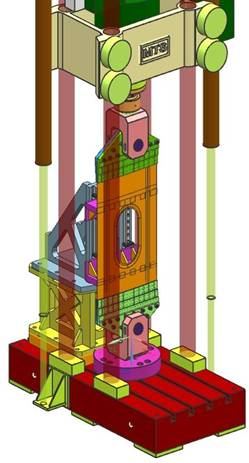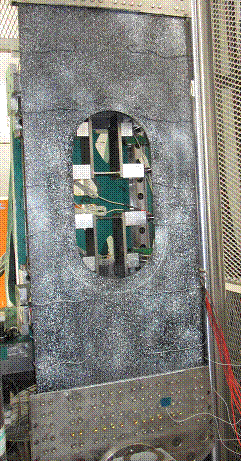Stiffened panels are required in structures which can be obtained by different processes. They can be made by attaching stiffeners to a thin panel or by producing integrally stiffened panels. An innovating manufacturing process based on Liquid Resin Infusion (LRI) can be employed for obtaining integrally stiffened panels. It is based on moulding a dry NCF (Non Crimp Fabric) pre-form of Carbon fibre plies, which is bonded by a one-shot injection process to high stiffness, pre-cured pre-preg T-section stiffeners. This method presents benefits like lower costs in machining and fewer assembly operations.
The structural behaviour of integrally stiffened panels is normally better than those panels with attached stiffeners, but the difference is difficult to quantify by analysis, and is dependant on the manufacturing technology. Especially, the major interest is to clarify the structural behaviour of the panels, and more specifically their critical mode of failure.
The immediate solution could be to carry on comparative structural tests on different coupons moulded by different manufacturing methods, but it must be taken into account that habitually employed strain and stress measuring systems are limited to specific predefined points or have limited resolution. As the manufacturing process and materials are expensive, and last a long term, few coupons are available. Therefore, carefully combined measurement systems must be employed to obtain as much information as possible during the test, and also recurrent information is desirable to correlate results obtained by different sources.
As an answer to this scenario, the ACID project was launched to explore and analyze some of the previous factors, trying to study comparatively the mechanical properties and behaviours of different panels obtained by different manufacturing processes.
To achieve this goal, a testing matrix was accomplished, based on 3 LRI coupons. Two of them are panels with attached stiffeners and the other one is an integrally stiffened panel. It is expected that the results obtained in the tests help to clarify the panels’ behaviour and allow comparing the mechanical advantages versus economic benefits of the manufacturing processes.
The main objectives of the project were described as follows:
- Carry on large scale structural tests for obtaining ultimate properties and failure modes of components manufactured by different processes.
- Measure strain and stress information during the test in a recurrent manner to combine and correlate the obtained signals which define the structural behaviour of the panels throughout the test.
- Analyze the obtained results, establishing a comparison between the behaviours of panels with attached stiffeners and integrally stiffened panels.
- Analyze the obtained results, establishing a qualitative comparison between the mechanical advantages versus economic benefits of the manufacturing processes.
The main achievements of the project were the validation of the novel techniques for composite manufacturing due to the result obtained in the tests. The final mechanical response of the differently implemented panels shows great similarities in the main mechanical characteristics (failure load, stiffness, failure mode).
This validation serves as a starting point for further methodologies development and means a widening of the possible applications or fields of Composite materials.
At the same time, the cross comparison of the measurement devices is useful when deciding the most convenient measurement system for each project. The pros and cons are highlighted and an estimative error between systems is obtained.
The major environmental benefit is the validation of the novel cleaner manufacturing composite methodologies (less energy needed, less wastes, lower costs) against conventional procedures in representative playground.

